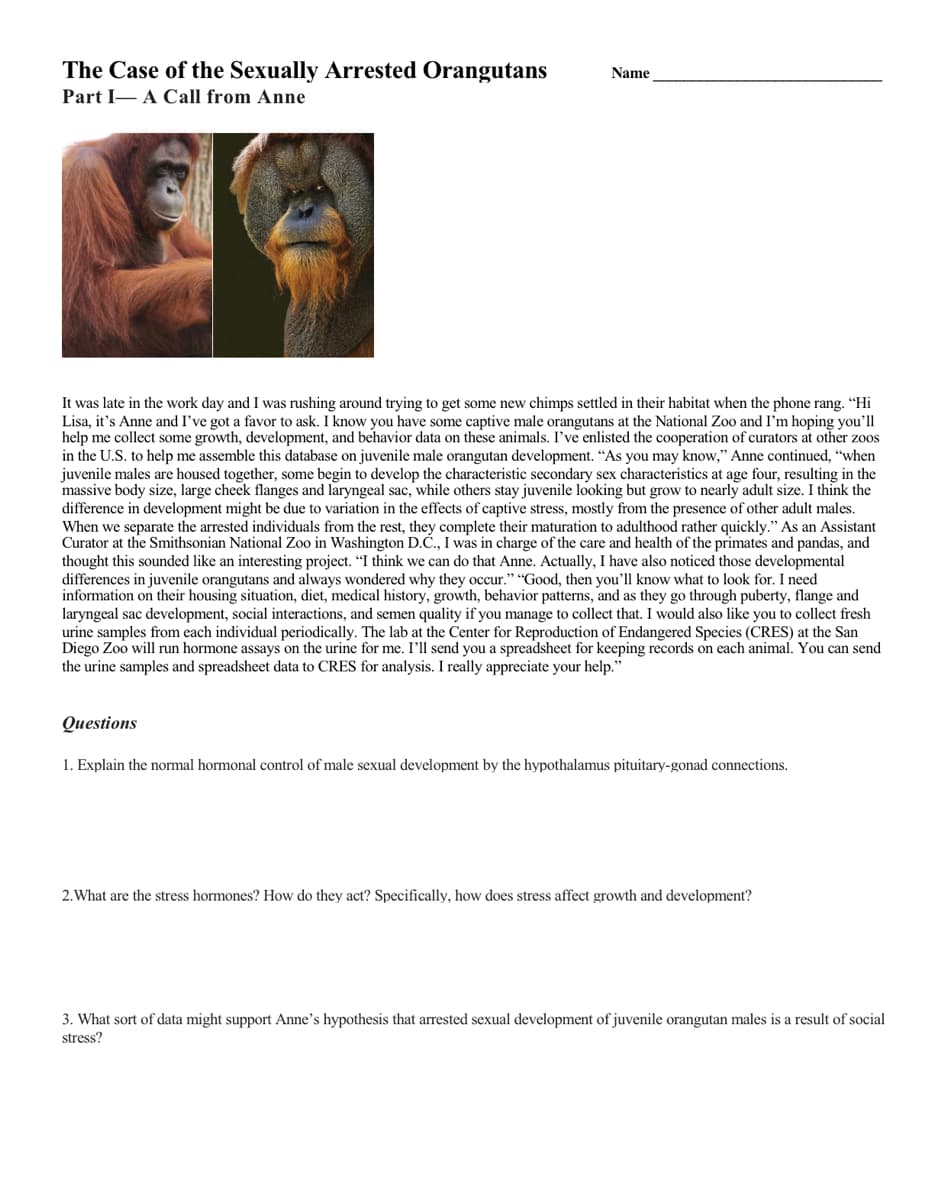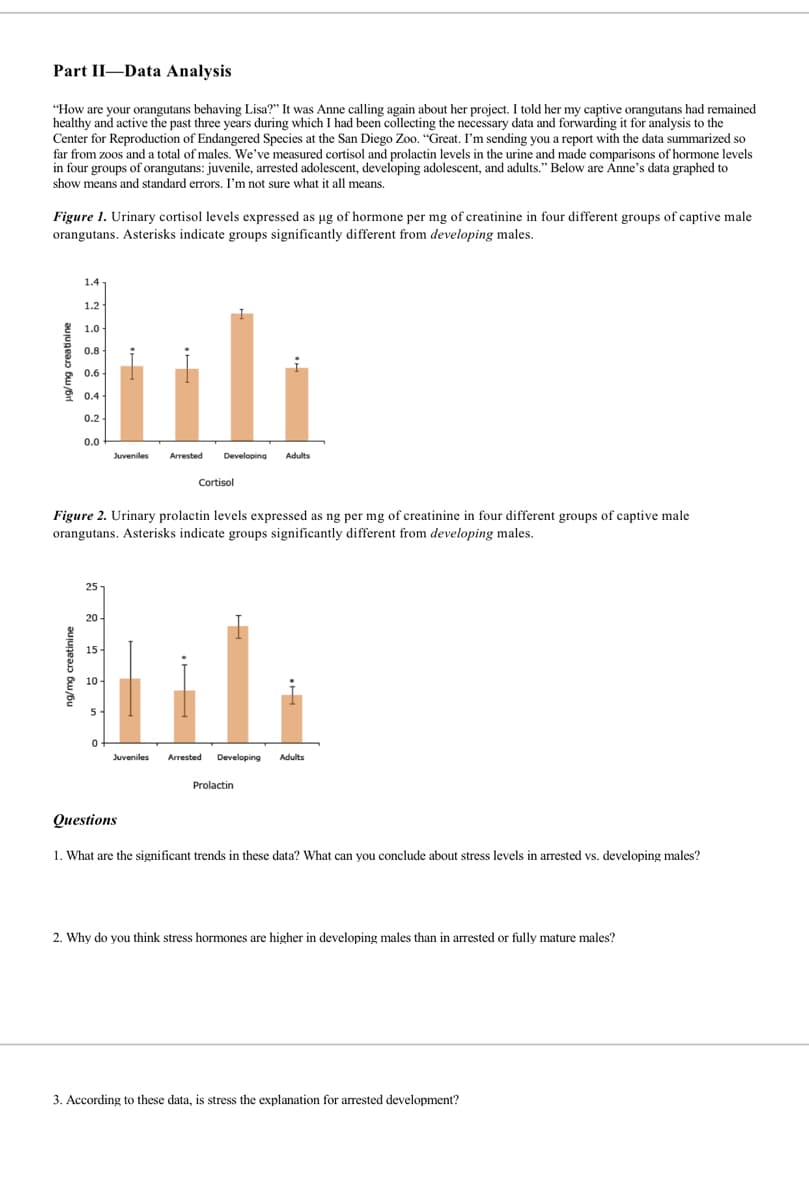Part I- A Call from Anne It was late in the work day and I was rushing around trying to get some new chimps settled in their habitat when the phone rang. “Hi Lisa, it's Anne and I've got a favor to ask. I know you have some captive male orangutans at the National Zoo and I'm hoping you'll help me collect some growth, development, and behavior data on these animals. I've enlisted the cooperation of curators at other zoos in the U.S. to help me assemble this database on juvenile male orangutan development. "As you may know," Anne continued, "when juvenile males are housed together, some begin to develop the characteristic secondary sex characteristics at age four, resulting in the massive body size, large cheek flanges and laryngeal sac, while others stay juvenile looking but grow to nearly adult size. I thỉnk the difference in development might be due to variation in the effects of captive stress, mostly from the presence of other adult males. When we separate the arrested individuals from the rest, they complete their maturation to adulthood rather quickly." As an Assistant Curator at the Smithsonian National Zoo in Washington D.Č., I was in charge of the care and health of the primates and pandas, and thought this sounded like an interesting project. "I think we can do that Anne. Actually, I have also noticed those developmental differences in juvenile orangutans and always wondered why they occur." "Good, then you'll know what to look for. I need information on their housing situation, diet, medical history, growth, behavior patterns, and as they go through puberty, flange and laryngeal sac development, social interactions, and semen quality if you manage to collect that. I would also like you to collect fresh urine samples from each individual periodically. The lab at the Center for Reproduction of Endangered Species (CRES) at the San Diego Zoo will run hormone assays on the urine for me. I'll send you a spreadsheet for keeping records on each animal. You can send the urine samples and spreadsheet data to CRES for analysis. I really appreciate your help." Questions 1. Explain the normal hormonal control of male sexual development by the hypothalamus pituitary-gonad connections.
Part I- A Call from Anne It was late in the work day and I was rushing around trying to get some new chimps settled in their habitat when the phone rang. “Hi Lisa, it's Anne and I've got a favor to ask. I know you have some captive male orangutans at the National Zoo and I'm hoping you'll help me collect some growth, development, and behavior data on these animals. I've enlisted the cooperation of curators at other zoos in the U.S. to help me assemble this database on juvenile male orangutan development. "As you may know," Anne continued, "when juvenile males are housed together, some begin to develop the characteristic secondary sex characteristics at age four, resulting in the massive body size, large cheek flanges and laryngeal sac, while others stay juvenile looking but grow to nearly adult size. I thỉnk the difference in development might be due to variation in the effects of captive stress, mostly from the presence of other adult males. When we separate the arrested individuals from the rest, they complete their maturation to adulthood rather quickly." As an Assistant Curator at the Smithsonian National Zoo in Washington D.Č., I was in charge of the care and health of the primates and pandas, and thought this sounded like an interesting project. "I think we can do that Anne. Actually, I have also noticed those developmental differences in juvenile orangutans and always wondered why they occur." "Good, then you'll know what to look for. I need information on their housing situation, diet, medical history, growth, behavior patterns, and as they go through puberty, flange and laryngeal sac development, social interactions, and semen quality if you manage to collect that. I would also like you to collect fresh urine samples from each individual periodically. The lab at the Center for Reproduction of Endangered Species (CRES) at the San Diego Zoo will run hormone assays on the urine for me. I'll send you a spreadsheet for keeping records on each animal. You can send the urine samples and spreadsheet data to CRES for analysis. I really appreciate your help." Questions 1. Explain the normal hormonal control of male sexual development by the hypothalamus pituitary-gonad connections.
Science Of Agriculture Biological Approach
5th Edition
ISBN:9780357229323
Author:Herren
Publisher:Herren
Chapter27: The Agriscience Fair
Section: Chapter Questions
Problem 2SLA
Related questions
Question

Transcribed Image Text:The Case of the Sexually Arrested Orangutans
Name
Part I- A Call from Anne
It was late in the work day and I was rushing around trying to get some new chimps settled in their habitat when the phone rang. "Hi
Lisa, it's Anne and I've got a favor to ask. I know you have some captive male orangutans at the National Zoo and I'm hoping you'll
help me collect some growth, development, and behavior data on these animals. I've enlisted the cooperation of curators at other zoos
in the U.S. to help me assemble this database on juvenile male orangutan development. "As you may know," Anne continued, “when
juvenile males are housed together, some begin to develop the characteristic secondary sex characteristics at age four, resulting in the
massive body size, large cheek flanges and laryngeal sac, while others stay juvenile looking but grow to nearly adult size. I thỉnk the
difference in development might be due to variation in the effects of captive stress, mostly from the presence of other adult males.
When we separate the arrested individuals from the rest, they complete their maturation to adulthood rather quickly." As an Assistant
Curator at the Smithsonian National Zoo in Washington D.Č., I was in charge of the care and health of the primates and pandas, and
thought this sounded like an interesting project. "I think we can do that Anne. Actually, I have also noticed those developmental
differences in juvenile orangutans and always wondered why they occur." "Good, then you'll know what to look for. I need
information on their housing situation, diet, medical history, growth, behavior patterns, and as they go through puberty, flange and
laryngeal sac development, social interactions, and semen quality if you manage to collect that. I would also like you to collect fresh
urine samples from each individual periodically. The lab at the Center for Reproduction of Endangered Species (CRES) at the San
Diego Zoo will run hormone assays on the urine for me. I'll send you a spreadsheet for keeping records on each animal. You can send
the urine samples and spreadsheet data to CRES for analysis. I really appreciate your help."
Questions
1. Explain the normal hormonal control of male sexual development by the hypothalamus pituitary-gonad connections.
2. What are the stress hormones? How do they act? Specifically, how does stress affect growth and development?
3. What sort of data might support Anne's hypothesis that arrested sexual development of juvenile orangutan males is a result of social
stress?

Transcribed Image Text:Part II-Data Analysis
"How are your orangutans behaving Lisa?" It was Anne calling again about her project. I told her my captive orangutans had remained
healthy and active the past three years during which I had been collecting the necessary data and forwarding it for analysis to the
Center for Reproduction of Endangered Species at the San Diego Zoo. "Great. I'm sending you a report with the data summarized so
far from zoos and a total of males. We've measured cortisol and prolactin levels in the urine and made comparisons of hormone levels
in four groups of orangutans: juvenile, arested adolescent, developing adolescent, and adults." Below are Ánne's data graphed to
show means and standard errors. I'm not sure what it all means.
Figure 1. Urinary cortisol levels expressed as ug of hormone per mg of creatinine in four different groups of captive male
orangutans. Asterisks indicate groups significantly different from developing males.
1.4
1.2
1.0
0.8
0.6
0.4
0.2
0.0
Juveniles
Arrested
Developina
Cortisol
Figure 2. Urinary prolactin levels expressed as ng per mg of creatinine in four different groups of captive male
orangutans. Asterisks indicate groups significantly different from developing males.
25
20
15
10
Juveniles
Arrested
Developing
Adults
Prolactin
Questions
1. What are the significant trends in these data? What can you conclude about stress levels in arrested vs. developing males?
2. Why do you think stress hormones are higher in developing males than in arrested or fully mature males?
3. According to these data, is stress the explanation for arrested development?
g/mg creatinine
aujugean bu/brl
Expert Solution
This question has been solved!
Explore an expertly crafted, step-by-step solution for a thorough understanding of key concepts.
This is a popular solution!
Trending now
This is a popular solution!
Step by step
Solved in 2 steps with 1 images

Knowledge Booster
Learn more about
Need a deep-dive on the concept behind this application? Look no further. Learn more about this topic, biology and related others by exploring similar questions and additional content below.Recommended textbooks for you





